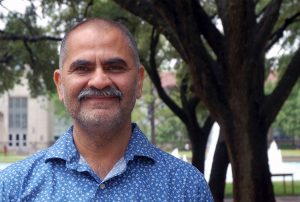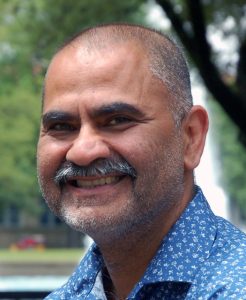 “All I knew about computer scientists was that they built calculators. Jumping into something I knew nothing about was exciting,” said Jaspal Subhlok, the Ph.D. alumnus from Rice University who is now in his third term as Chair of the Department of Computer Science at the University of Houston. “This was back in 1980. I was in the aeronautical engineering program at the Indian Institute of Technology, Kharagpur and I had recently realized that India was not designing aircrafts.”
“All I knew about computer scientists was that they built calculators. Jumping into something I knew nothing about was exciting,” said Jaspal Subhlok, the Ph.D. alumnus from Rice University who is now in his third term as Chair of the Department of Computer Science at the University of Houston. “This was back in 1980. I was in the aeronautical engineering program at the Indian Institute of Technology, Kharagpur and I had recently realized that India was not designing aircrafts.”
Subhlok said he reviewed his interests and skills and concluded that he enjoyed logic and mathematics the most. He was told that is what computer science was about, so he switched to the CS program. After completing his undergraduate degree, he applied to graduate schools in the United States and was accepted to several of his top choices. To make his final decision, he wrote to the professors he wanted to work with.
“I contacted Ken Kennedy at Rice and I really didn’t know what I was talking about. I just said I was interested in algorithms, programming languages, this and that. Then I got this wonderful reply from Ken. His letter wasn’t just ‘you should come here,’ he went into detail and said, ‘If parallel computing is what you want to study, then I’ll be happy to work with you, If it’s programming languages, I’ll direct you to Professor Cartwright,’ and so on. That is what drew me to Rice. If I got letters back from the other schools, they seemed obviously typed by a secretary. The half hour or so Ken Kennedy spent personalizing my letter made the difference – it worked.”
Three decades later, Subhlok reflects on the way computer scientists approach their problems. He said everything looks different on the surface but the roots of CS remain unchanged.
“Back then we were working on a computer that took up a giant hall and everything was much slower. Even before Rice, I had been programming on data punch cards – a stack of cards was your program. If you dropped the stack you had to re-order the cards. A week after submitting your program you would finally find out if it worked or not. Things have come a long way, but the basics of programming are not that different. Computational principles are not that different. At its root, computer science has always been about using electronic and mathematical advancements to solve problems. That’s not going to change. We have a problem, we figure out how to solve it, how to spell it out to the computer so it can solve it for you.”
Although he’s had several high points over his academic and research career, he finds the greatest pride in what his department has accomplished since he began serving as its chair. He said the role is an interesting and challenging combination of working with diverse groups like the university’s administration and friends in industry, all the while making sure that the needs of students and faculty members are served.
 “In the last few weeks, my conversations have included talking to faculty members we’re trying to hire, alumni who are committed to helping us advance, getting final bids on renovation projects, and enhancing the curriculum. As a chair, you have to think of the big picture all the time. Where does the department need to be in five years or ten? But the combination of being in the trenches and addressing the future directions and issues is challenging and rewarding.”
“In the last few weeks, my conversations have included talking to faculty members we’re trying to hire, alumni who are committed to helping us advance, getting final bids on renovation projects, and enhancing the curriculum. As a chair, you have to think of the big picture all the time. Where does the department need to be in five years or ten? But the combination of being in the trenches and addressing the future directions and issues is challenging and rewarding.”
Subhlok says his frustrations are usually due to the ten things he wants to accomplish in a week that get side-tracked in the day-to-day activities, and he attributes his success to the quality of the people he works with. He said, “It is simply because we’ve had really good people. We’re one community as a department, with little internal negative politics. As a chair, there are so many things you could do that choosing a direction requires a compass. For me, that compass is something that will lead to long term student success. It’s the only reason for a university to exist, and we forget that sometimes because of other things we are focused on.”
Over the last six years, his department has changed the way they approach the teaching responsibility of their faculty members. “The typical model has often been for each professor to teach X courses a year,” said Subhlok, “but we decided to look at it differently: these are our students and this is what needs to be taught. How do we share that responsibility fairly? How do we provide the best possible education to students but not overload the faculty? ” The process involved evaluating every course being taught for its value to the program and introducing new courses. “If we offered courses in the past only because it helped someone meet their teaching workload requirement, we dropped the course. If it was is not important to student success, it is no longer being taught.”
At the same time the curriculum has been aligned to what students needed to succeed, which means the undergraduate and graduate programs look different. “The undergraduate students needed more exposure to emerging computer science topics, so the new program allows for more CS electives. The graduate students need more depth in their specializations –like distributed computing or data analytics– so specialization tracks were added,” said Subhlok, whose focus had also including building up the UH CS community.
“Our alumni and industry supporters have been terrific. They say, ‘tell us what you need and we’ll get it done.’ But we’ve also gotten lucky because the faculty we’ve recruited have all been excellent. We recruit them for life and then try to make sure they get what they need from us.”
He is also determined to balance research and teaching. “That’s a very important issue in CS. Research and education can co-exist together beautifully in an ideal world, but it doesn’t always happen. A lot of time we are so lost in our research, we forget we are here for the students. For this to work really well, student success and faculty success have to be aligned.
“You can’t say the only thing you will reward is the number of papers published, then expect faculty to be wonderful teachers. Internally, we’ve changed the way we look at merit raises. If a faculty member really enjoys teaching, they can focus on teaching and really succeed. Other faculty are really interested in research and can spend more time focusing on that.”
Subhlok has been pleasantly surprised at the response to a cultural shift that really values student success. “The faculty members always meet the need. We realize we need a course that we aren’t currently teaching and it’s going to require months to set it up? Done. Someone will step up. Here, research and teaching co-exist very well.”
Jaspal Subhlok completed his B.A. in Computer Science in 1991. His adviser was Ken Kennedy.
